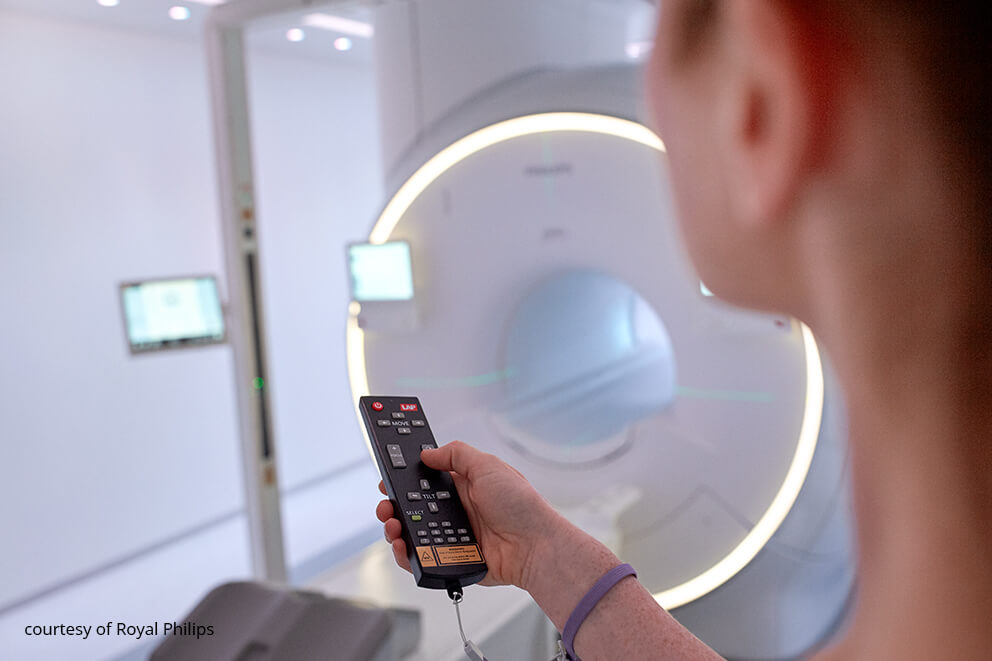System integration and intelligence are marking the future in patient positioning
Developing open interfaces between lasers and imaging and radiotherapy systems from multiple OEMs will make patient positioning and alignment task even faster and more convenient for the patient.
The text was originally published in the Summer Issue of EMP News by European Federation Of Organizations For Medical Physics – EFOMP.
Hypofractionated radiation therapy is on the rise. While receiving a higher dose per fraction in fewer sessions makes not only sense for an improved patient experience but also for the treatment facility in terms of reduced costs of caring and increased patient throughput, it makes precision even more important. Protecting patients against ionizing radiation to healthy tissue is essential. To achieve the goal of concentrating the radiation directly on the tumor, patient positioning needs to be exact and reproducible for every treatment session. Hereby lasers have one important task: to support the patient positioning and alignment as precise as possible in the most time saving way. To safe precious linac time the setup and preparation of patient positioning tasks can already be done in the CT room.
Starting in the treatment chain the first step is the imaging of the patient. After positioning and immobilizing the patient, a CT image is created, followed by an optional step of virtual simulation. The coordinates of the target point are identified, and the patient gets marked. To get higher soft tissue contrast, MR imaging might follow for certain cancer types (e.g. brain). Here, the patient must be positioned and oriented identically to the CT imaging to match the image data from CT and MR. Once more precision and accuracy play a major role as does safety. By the way, LAP’s DORADOnova MR3T and APOLLO MR systems are the only laser systems in MR environment which are FDA 510(k) cleared. The treatment itself will be performed at the LINAC after the treatment planning. Here again the patient must be positioned, immobilized and aligned according to the target point followed by the irradiation. It is important that the immobilization from the CT is replicable multiple times at the LINAC for each fraction of the treatment.
To summarize these steps: There are different coordinate systems in the treatment chain: the coordinate system of the CT and MR, the coordinate system of the patient and the coordinate system of the treatment machine. While planning and treating patients, these coordinate systems need to be congruent. LAP offers an independent and reliable coordinate system projected with laser for every step. Lasers at CT, MR and LINAC help to match these coordinate systems so that the treatment is successful and time efficient. The lasers are also used as a machine independent reference to regularly perform QA tasks.
All workflows in CT and MR are perfectly supported by LAP’s DORADO and DORADOnova laser systems. Together with the CARINAnav control system which offers two standard interfaces for data exchange and one interface for direct laser steering integrated in syngo.via RT Image Suite of Siemens Healthineers. LAP systems are the only laser systems that offer this significant advantage of system integration. This is also where we see a strong potential in the future: integrating our systems with dedicated interfaces in the RT environment to reduce system borders and minimize use errors.
Developing open interfaces between lasers and imaging and radiotherapy systems from multiple OEMs will make patient positioning and alignment task even faster and more convenient for the patient. All while keeping the usability simple and easy to handle. Furthermore “built in intelligence” could be useful in tracking geometric deformations in patient anatomy from treatment session to treatment session and adjust accordingly. These and further developments are shaping the future of patient positioning.

